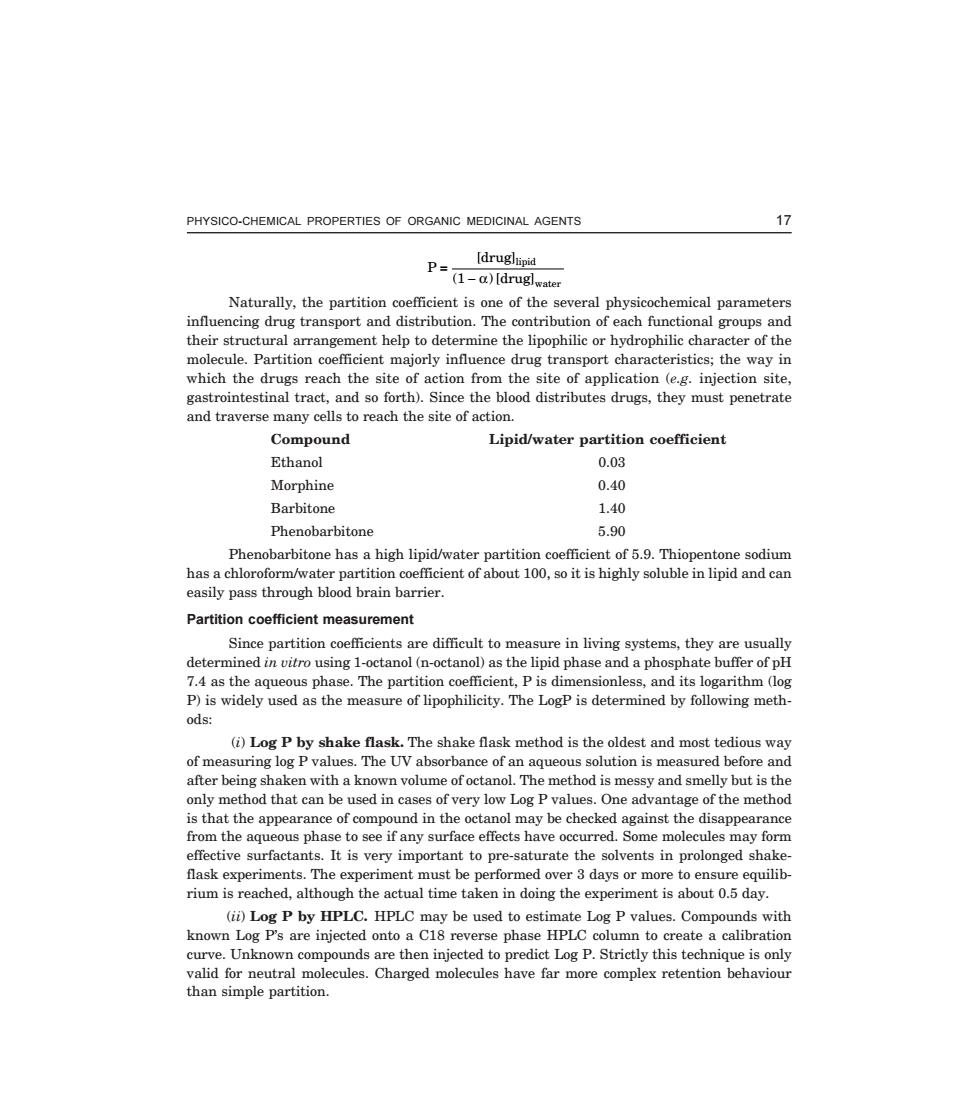正在加载图片...

PHYSICO-CHEMICAL PROPERTIES OF ORGANIC MEDICINAL AGENTS 17 [drughipid P=(1-a)druglater Naturally,the partition coefficient is one of the several physicochemical parameters influencing drug transport and distribution.The contribution of each functional groups and their structural arrangement help to determine the lipophilic or hydrophilic character of the molecule.Partition coefficient majorly influence drug transport characteristics;the way in which the drugs reach the site of action from the site of application (e.g.injection site, gastrointestinal tract,and so forth).Since the blood distributes drugs,they must penetrate and traverse many cells to reach the site of action. Compound Lipid/water partition coefficient Ethanol 0.03 Morphine 0.40 Barbitone 1.40 phenobarbitone 5.90 Phenobarbitone has a high lipid/water partition coefficient of 5.9.Thiopentone sodium has a chloroform/water partition coefficient of about 100,soit is highly soluble in lipid and can easily pass through blood brain barrier. Partition coefficient measurement since partition coefficients are difficult to measure in living systems.they are usually determined in vitro using 1-octanol (n-octanol)as the lipid phase and a phosphate buffer of pH 7.4 as the aqueous phase.The partition coefficient,P is dimensionless. and its logarithm (log P)is widely used as the mea re of lipophilicity.The LogP is dete termined by following meth ods: (i)Log P by shake flask.The shake flask method is the oldest and most tedious way of measuring log Pvalues.The UV absorbance of an aqueous solution is measured before and after being shaken with a known volume of octanol.The method is messy and smelly but is the only method that can be used in cases of very low Log P values.One advantage of the method is that the appearance of compound in the octanol may be checked against the disappearance from the aqueous phase to see if any surface effects have occurred.Some molecules may form effective surfactants.It is very important to pre-saturate the solvents in prolonged shake flask experiments.The experiment must be performed over 3 days or more to ensure equilib- rium is reached.although the actual time taken in doing the experiment is about .5 day. (ii)Log P by HPLC.HPLC may be used to estimate Log P values.Compounds with known Log P's ar cted to a C18 hase hpic colur e.Unk dict Log P.Strictly this e is alid fo nolecules. than Charged far more complex rete tion ple pPHYSICO-CHEMICAL PROPERTIES OF ORGANIC MEDICINAL AGENTS 17 C-8—N-CHEMI\CHE3-1.PM5 P = [drug] (1 drug] lipid − α water )[ Naturally, the partition coefficient is one of the several physicochemical parameters influencing drug transport and distribution. The contribution of each functional groups and their structural arrangement help to determine the lipophilic or hydrophilic character of the molecule. Partition coefficient majorly influence drug transport characteristics; the way in which the drugs reach the site of action from the site of application (e.g. injection site, gastrointestinal tract, and so forth). Since the blood distributes drugs, they must penetrate and traverse many cells to reach the site of action. Compound Lipid/water partition coefficient Ethanol 0.03 Morphine 0.40 Barbitone 1.40 Phenobarbitone 5.90 Phenobarbitone has a high lipid/water partition coefficient of 5.9. Thiopentone sodium has a chloroform/water partition coefficient of about 100, so it is highly soluble in lipid and can easily pass through blood brain barrier. Partition coefficient measurement Since partition coefficients are difficult to measure in living systems, they are usually determined in vitro using 1-octanol (n-octanol) as the lipid phase and a phosphate buffer of pH 7.4 as the aqueous phase. The partition coefficient, P is dimensionless, and its logarithm (log P) is widely used as the measure of lipophilicity. The LogP is determined by following methods: (i) Log P by shake flask. The shake flask method is the oldest and most tedious way of measuring log P values. The UV absorbance of an aqueous solution is measured before and after being shaken with a known volume of octanol. The method is messy and smelly but is the only method that can be used in cases of very low Log P values. One advantage of the method is that the appearance of compound in the octanol may be checked against the disappearance from the aqueous phase to see if any surface effects have occurred. Some molecules may form effective surfactants. It is very important to pre-saturate the solvents in prolonged shakeflask experiments. The experiment must be performed over 3 days or more to ensure equilibrium is reached, although the actual time taken in doing the experiment is about 0.5 day. (ii) Log P by HPLC. HPLC may be used to estimate Log P values. Compounds with known Log P’s are injected onto a C18 reverse phase HPLC column to create a calibration curve. Unknown compounds are then injected to predict Log P. Strictly this technique is only valid for neutral molecules. Charged molecules have far more complex retention behaviour than simple partition